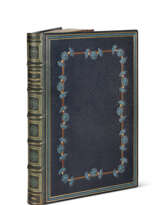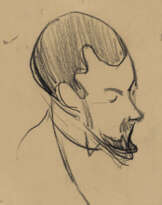ID 1051702
Lot 113 | Armand Seguin (1869-1904)
Valeur estimée
€ 40 000 – 60 000
Paysans au travail
huile sur toile
30 x 41.4 cm.
Peint vers 1893
oil on canvas
11 ¾ x 16 ¼ in.
Painted circa 1893
Provenance
Madame Seifert, Paris.
Robert Caby, Paris.
Sam Josefowitz, Pully (acquis auprès de celui-ci le 15 octobre 1960).
Puis par descendance aux propriétaires actuels.
Exhibited
Dallas, Dallas Museum of Fine Arts, The Outline and the dot, Two aspects of Post-Impressionism, mars 1962, no. 16.
Londres, The Tate Gallery, Gauguin and the Pont-Aven Group, janvier-février 1966, p. 38, no. 168 (titré ‘Famille de Pêcheurs’).
Zurich, Kunsthaus, Pont-Aven, Gauguin und sein Kreis in der Bretagne, mars-avril 1966, p. 80, no. 233 (titré ‘Famille de Pêcheurs‘).
Pont-Aven, Musée de Pont-Aven, Armand Seguin, juin-octobre 1989, no. 5 (illustré en couleurs).
Further details
“Seguin est avant tout un cérébral – je ne dis pas, certes, un littéraire – qu’il exprime non ce qu’il voit mais ce qu’il pense par une originale harmonie des lignes, par un dessin curieusement compris dans l’arabesque. […] Seguin a librement étudié la nature. C’est en Bretagne cette année que je l’ai connu. Cette belle Bretagne je l’ai peinte autrefois. J’en ai scruté les horizons, cherchant l’accord de la vie humaine avec la vie animale et végétale dans des compositions où je laissais une importante part à la grande voix de la terre. Seguin, au contraire, se contente pour ses figures d’un entourage restreint. De cette méthode, il tire de très heureux effets.”
P. Gauguin, ‘Préface’, in Armand Séguin, Exposition d’œuvres nouvelles, cat. exp., Le Barc de Boutteville, Paris, 1895, p. 9-11
“Seguin is above all a cerebral artist - I am not saying, of course, a literary artist - he expresses not what he sees but what he thinks through an original harmony of lines, through a drawing curiously included in the arabesque. […] Seguin freely studied nature. It was in Brittany this year that I got to know him. I once painted this beautiful Brittany. I scanned its horizons, seeking the harmony of human life with animal and plant life in compositions in which I allowed the great voice of the earth to play an important part. Seguin, on the other hand, contented himself with a restricted environment for his figures. From this method, he draws very happy effects.”
P. Gauguin, 'Préface', in Armand Séguin, Exposition d'oeuvres nouvelles, exh. cat., Le Barc de Boutteville, Paris, 1895, p. 9-11.
Né en Bretagne en 1869, Armand Seguin est arrivé à Paris pour étudier à l'École des Arts Décoratifs, mais n'a suivi les cours que brièvement. Davantage autodidacte, Seguin affirme dans ses mémoires, que suite à sa visite de l'exposition du Groupe Impressionniste et Synthétiste au Café Volpini à Paris, en 1889, il fut «captivé par les tableaux de Gauguin, Bernard, Filiger et Laval, si nets, si affirmatifs et si beaux».
Agé d’à peine 20 ans, Seguin se convertit alors au style synthétiste, évolue au sein d'un groupe de jeunes peintres de l'Académie Julian et admire Gauguin. Ce n’est cependant qu’en 1894 qu’il rencontre son maître, au retour du premier séjour de Gauguin à Tahiti. Ce dernier tenta de le persuader de le suivre à Tahiti, avec leur ami O’Conor, mais Seguin, conscient de l'emprise du maître, n'accepta l'invitation. Gauguin et Seguin mourront tous deux en 1903, à quelques mois d'intervalle, mais à l'autre bout du monde.
Aujourd’hui davantage connu comme imprimeur et illustrateur ; son œuvre peint est rare et serait composé de seulement une quinzaine de tableaux (R. S. Field, C. L. Strauss et S. J. Wagstaff, Jr., The Prints of Armand Seguin, cat. exp, Davison Art Center, Middletown, 1980, p. 69-70). Néanmoins, ceux qui ont connu Seguin, avant sa mort à 34 ans, ont salué son œuvre. Ce fut notamment le cas de Gauguin. "Seguin est avant tout un penseur", écrit Gauguin dans sa préface au catalogue de l’exposition personne de Seguin à la galerie Le Barc de Boutteville en 1895. "Il ne peint pas seulement ce qu'il voit, mais ce qui lui vient à l'esprit, et ce grâce à une harmonie novatrice des lignes" (cité in Post- Impressionism, cat. ex., Royal Academy of Arts, Londres, 1979, p. 127).
Born in Brittany, in 1869, Armand Séguin moved to Paris to study at the École des Arts Décoratifs, but only briefly attended classes. Being more self-taught, Séguin wrote in his memoir that on his visit to the exhibition of the Impressionist and Synthetist Group at the Café Volpini, in Paris in 1889, he was “captivated by the paintings of Gauguin, Bernard, Filiger, and Laval, that were so clear, so affirmative, and so beautiful”.
When he was aged barely twenty, Seguin switched to the synthesist style, which had developed among a group of young painters from the Académie Julian, and who looked up to Gauguin. He only met his master, Gauguin, in 1894, when he returned from his first stay in Tahiti. The latter tried to persuade him to follow him to Tahiti, along with their friend O’Conor. However, Seguin, resisted the charms of Gauguin and did not accept the invitation. Gauguin and Seguin both died in 1903, only a few months apart, but on opposite sides of the globe.
Today best known as a printer and an illustrator, his know painted works are extremely rare, forming a total of even twenty paintings (R.S. Field, C.L. Strauss and S.J. Wagstaff, Jr., The Prints of Armand Seguin, cat. exp, Davison Art Center, Middletown, 1980, p. 69-70). Nevertheless, the people who knew Seguin, before his death at the age of 34, praised his work. This was notably true of Gauguin. “Seguin is first and foremost a thinker”, wrote Gauguin in his preface to the catalogue of the Seguin exhibition at the Le Barc de Boutteville gallery, in 1895. “He not only paints what he sees, but also what comes to his mind, thanks to an innovative harmony of lines” (quoted in Post-Impressionism, cat. ex., Royal Academy of Arts, London, 1979, p. 127).
| Artiste: | Armand Seguin (1869 - 1903) |
|---|---|
| Technique appliquée: | Huile sur toile |
| Catégorie maison de vente aux enchères: | Peintures |
| Artiste: | Armand Seguin (1869 - 1903) |
|---|---|
| Technique appliquée: | Huile sur toile |
| Catégorie maison de vente aux enchères: | Peintures |
| Adresse de l'enchère |
CHRISTIE'S 9 Avenue Matignon 75008 Paris France | ||||||||||||||
|---|---|---|---|---|---|---|---|---|---|---|---|---|---|---|---|
| Aperçu |
| ||||||||||||||
| Téléphone | +33 (0)1 40 76 85 85 | ||||||||||||||
| Fax | +33 (0)1 40 76 85 86 | ||||||||||||||
| Conditions d'utilisation | Conditions d'utilisation | ||||||||||||||
| transport |
Service postal Service de messagerie ramassage par vous-même | ||||||||||||||
| Modes de paiement |
Virement bancaire | ||||||||||||||
| Heures d'ouverture | Heures d'ouverture
|














